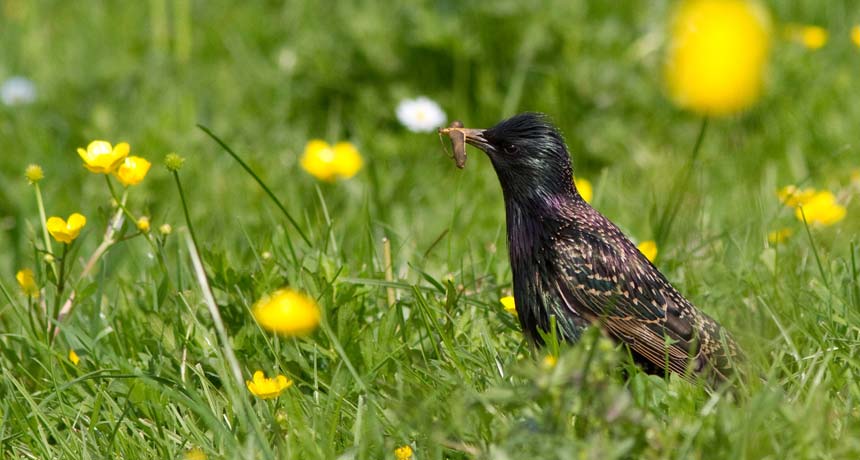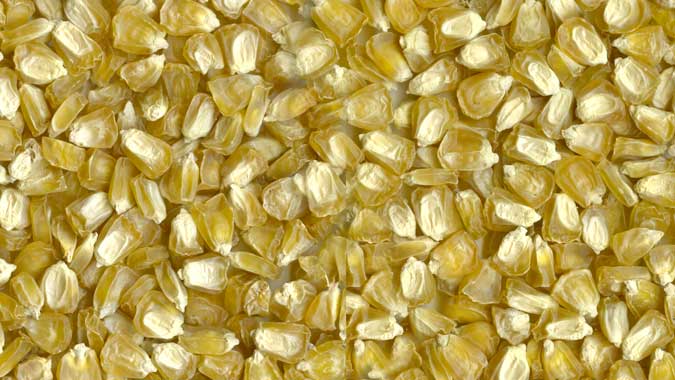Bug-killer linked to decline in birds
A Dutch study finds that spraying bug killers on crops can reduce the number of insect-eating birds

A new study suggests poisons used to kill insects may also affect bug-eating birds, such as this starling.
JOUKE ALTENBURG, RADBOUD UNIV
Share this:
- Share via email (Opens in new window) Email
- Click to share on Facebook (Opens in new window) Facebook
- Click to share on X (Opens in new window) X
- Click to share on Pinterest (Opens in new window) Pinterest
- Click to share on Reddit (Opens in new window) Reddit
- Share to Google Classroom (Opens in new window) Google Classroom
- Click to print (Opens in new window) Print
By Stephen Ornes and Janet Raloff
Farmers often use chemicals to kill the bugs that dine on crops. But insects aren’t the poisons’ only victims. A new study links widespread use of one insecticide with a drop in the number of local birds. A second study finds relatively high levels of this chemical — and related ones — taint rivers that drain off of U.S. farmlands.
Both studies focused on bug killers known as neonicotinoids (nee-oh-NIK-uh-tin-oydz). Earlier research showed these chemicals can harm honeybees and bumblebees. Both are important because they pollinate plants. That includes many that people eat. Now scientists are linking the chemicals to shrinking bird populations. Researchers don’t yet know what role the chemicals play. They may poison the birds or just deprive them of the insects they need to eat.
Whatever the reason, “the effects could be more widespread in the ecosystem than we thought,” Ruud Foppen told Science News. He’s a bird researcher at Sovon, the Dutch Center for Field Ornithology in Nijmegen.
Farmers spray neonicotinoids on crops. They also buy seeds coated with these insecticides. Rains can then wash these treatments off farm fields and into nearby lakes and rivers.
Sampling these waters can be a good way to track the use of pesticides in an area. And that’s what Foppen and his colleagues did. They looked at Dutch water pollution data from 2003 to 2009. They focused on imidacloprid (ih-MEED-uh-KLOH-prid). It’s the most commonly used neonicotinoid in that area. They also examined surveys of 15 insect-eating birds. Nine of the species eat nothing but insects. The rest feed insects to their babies. Scientists tallied those birds from 2003 to 2010.
Foppen’s group was able to link the bird and pesticide data. After imidacloprid showed up in the water — which would have happened only after farmers started using the chemical on their crops — bird numbers began to fall. And the more imidacloprid in local streams, the bigger a decline in birds compared to the last year.
The scientists looked for other possible explanations on why bird numbers fell. Only imidacloprid seemed to explain the yearly decrease seen in local birds.
Foppen and his team published their findings July 9 in Nature.
Bird numbers may be falling because the bug killers are leaving fewer insects for them to eat, the researchers say. Or it’s possible that the chemicals may poison the birds directly when they dine on treated bugs.
Other ecologists are taking note of the findings. Scientists had suspected that neonicotinoids might affect species other than bees. But the new study is the first to find direct evidence for this, says Dave Goulson. He’s an ecologist at the University of Sussex in England.
“This moves the debate on quite a bit,” he told Science News.
Use also widespread in United States
Neonicotinoids also are being widely used in the U.S. Midwest, according to new data by scientists with the U.S. Geological Survey. Many cereal grains and soybeans are grown throughout the Midwest. Not surprisingly, it has come to be known as the American “breadbasket.”

The chemicals showed up in every stream. The levels varied, however, over time. “We noticed higher levels of these insecticides after rain storms during crop planting,” Hladik says. And this makes sense. Today, most U.S. corn and soybeans come from seeds that had been coated with neonicotinoids. However, she adds, “the insecticides also were detected prior to their first use during the growing season.” That suggests, she says, “that they can persist” in the environment from at least the past year.
Long-term exposure to even low levels of these chemicals can poison fish and other aquatic animals. Concentrations of just 10 to 100 nanograms (billionths of a gram) per liter of imidacloprid can prove toxic to such organisms. The new study found levels of up to 42.7 nanograms per liter of this insecticide in Iowa rivers. Clothianidin (Klo-thee-AN-ih-din) was the most commonly detected neonic in these rivers. It showed up in 75 percent of the 79 water samples. The highest level seen: 257 nanograms per liter of water. The findings will appear in the October issue of the journal Environmental Pollution.
Hladik’s team concludes that the “near universal” use of neonic-coated seeds by U.S. farmers now “needs to be closely examined in relation to environmental impacts of these insecticides.”
Power Words
ecology A branch of biology that deals with the relations of organisms to one another and to their physical surroundings. A scientist who works in this field is called an ecologist.
ecosystem A group of interacting living organisms — including microorganisms, plants and animals — and their physical environment within a particular climate. Examples include tropical reefs, rainforests, alpine meadows and polar tundra.
insecticide A poison applied to kill insects.
ornithology The scientific study of birds.
pesticide A chemical or mix of compounds used to kill insects, rodents or other organisms harmful to cultivated plants, pet or livestock, or unwanted organisms that infest homes, offices, farm buildings and other protected structures.
pollinate To transport male reproductive cells — pollen — to female parts of a flower. This allows fertilization, the first step in plant reproduction.
U.S. Geological Survey, or USGS This is the largest nonmilitary U.S. agency charged with mapping water, Earth and biological resources. It collects information to help monitor the health of ecosystems, natural resources and natural hazards. It also studies the impacts of climate and land-use changes. A part of the U.S. Department of the Interior, USGS is headquartered in Reston, Va.







